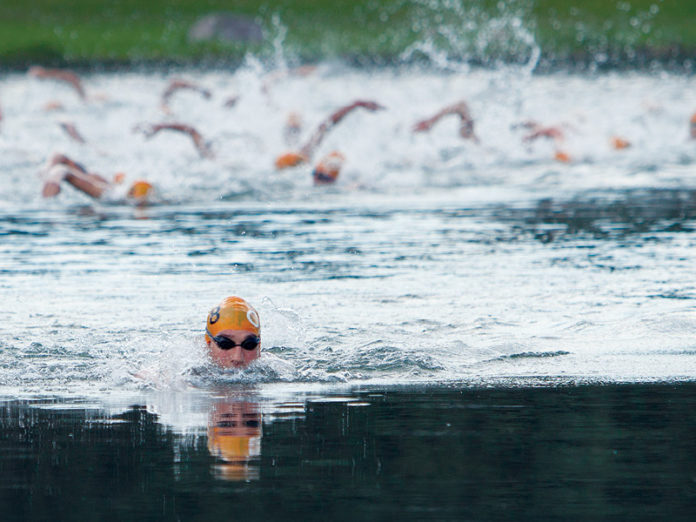
One of the principle hurdles for a new triathlete is the fear of open water swimming. For many, open water pushes them beyond their comfort zone, creating anxiety, uncertainty and a multitude of questions. Open water swimming, let alone ocean swimming, is very different from pool swimming, but can be conquered with some work.
Open water swimming is chaotic. Athletes will be bumped, swam over and perhaps even punched or dunked. Do not fear. Always remember to be calm, confident and comfortable in the water. Should panic strike, simply pause and lift your head out of the water to regain your composure.
Open water swimming is very different from the pool. Currents, waves and a varied landscape can all add to the challenge. Practice sighting to help navigate an open water course. Sighting involves lifting the head out of the water to direct you toward the next buoy or the shore. Swimmers rarely swim straight, so to avoid turning a 1,500 metre swim into 2000 metres, learn to sight and swim straight.
Practice this in the pool by sighting 1-2 times per length during practice. On each sight, lift your head as little as possible, while focusing on an object on the pool deck. On the race course, look for large objects to help get your bearings, such as houses, trees, channel markers or banners that will provide direction on race day.
Practice is the best way to prepare for an open water swim, whether you are in open water or the pool. In the pool, simulate open water by swimming in a group, purposely bump, push and contact one another. The contact in these practice sessions prepares an athlete mentally and physically for race day. Getting used to crowded water will help alleviate anxiety when the gun sounds.
Investigate water temperatures and weather forecasts and test the water a day or two prior. Walk through entry and exit points for the swim and note whether the water is muddy, clear, salty or fresh, warm or cool. Each race governing body has cut-off temperatures for allowing wetsuits, so ask the race organizers. Most races will not allow neoprene booties or gloves, unless the water is extremely frigid. Neoprene caps may be worn on cold swims, however some may find them restrictive in the neck and prefer to wear two swim caps instead for warmth.
Swim skins are not necessary in non-wetsuit swims, but they do provide a competitive advantage as they can be extremely fast in the water compared to a traditional race suit.
Another key to enjoying this open water adventure is seeding properly. Planning to be the first one out of the water? Start at the front, embrace the chaos and be prepared for a washing machine of athletes for the first couple minutes. Many athletes do not want this chaos. These athletes should start towards the back, wait a few seconds for the more aggressive racers to start and then proceed into the water. This tactic may impact race time, but enhance the experience and allow an athlete to compete in events previously deemed unattainable.
Prior to race start, get into the water for a short swim. This allows your body to acclimatize to the water and alleviates nervousness. If the race does not allow warm-up swims, splash some water on your face and get ready to race.
Embracing the chaos of open water swimming provides an edge on the competition. Proper preparation and due diligence will bring you to the start line confident and excited to race. Open water swimming is an incredible experience, so do not let your fears limit race options.
Get out there and swim.
What to Look for in a Wetsuit
A triathlon wetsuit serves many functions. It insulates you from cold water and is buoyant so it keeps you floating. The hydrodynamic nature of neoprene rubber construction repels water and helps you slip through the water, swimming faster and conserving energy.
Fit is key. Find a shop that will fit you properly and ensure you feel comfortable in the wetsuit. It should feel like a second skin. It almost always makes sense to go full sleeve, unless your body shape dictates otherwise, or you tend to overheat in the water. Full sleeve provides added warmth and hydrodynamics that a sleeveless suit is unable to provide. Make sure the shoulders allow for good mobility.
Prices range from $200 to more than $1,000 for a wetsuit, so do your homework on the model that is best for you. Renting a wetsuit is also an option and a great way to find a brand that you prefer.

















